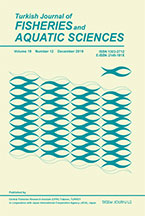From Germs to Mammals in Aqua
CiteScore: 1.0
SCOPUS 2023
SCOPUS 2023

This journal is licensed under a Creative Commons Attribution-NonCommercial-NoDerivatives 4.0 International License
Genetics of Aquatic Organisms
2018, Vol 2, Num, 2 (Pages: 35-41)
Development and assessment of a multiplex PCR assay for genetic analyses of microsatellite loci in beluga sturgeon, Huso huso
2 Danube Delta National Institute for Research and Development, 165 Babadag Str., 820112 Tulcea, Romania DOI : 10.4194/2459-1831-v2_2_02 Viewed : 7774 - Downloaded : 4143 The survival of the critically endangered beluga sturgeon, Huso huso, depends – among others – on an effective fisheries management and supportive stocking. To gather the necessary knowledge on the genetic diversity and structure of still existing wild populations, microsatellite loci from related sturgeon species were tested for their cross-species amplification ability and species-specific loci were newly isolated using 454 GS-FLX Titanium pyrosequencing. Twelve suitable polymorphic microsatellites could be identified and were characterized in 58 beluga sturgeons (18 farmed; 40 wild). The observed total number of alleles per locus ranged from 4 to 18 with moderate to high levels of polymorphism. The wild individuals were significantly more diverse with a mean number of 8.08 alleles per locus than the farmed ones with 4.33 alleles per locus. In contrast, observed heterozygosities did not differ significantly among both groups. Genic and genotypic differentiation across all loci was highly significant between farmed and wild beluga sturgeons. The high sensitivity and discriminatory power of the 12 loci were proven by a very low overall probability of identity for siblings (PIsib=3.099 × 10−5) and a high accuracy of self-classification (98.3%). Thus, this multiplex PCR assay represents a valuable genetic toolbox for species conservation measures. Keywords : Acipenseridae, conservation genetics, genetic diversity, nuclear DNA, population structure















